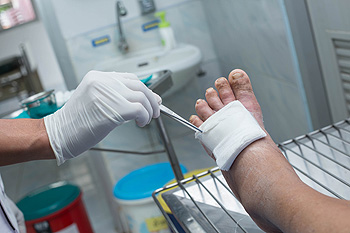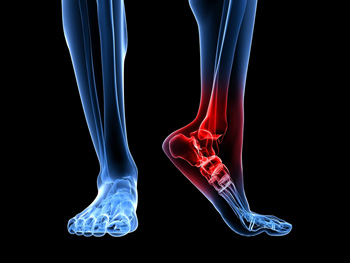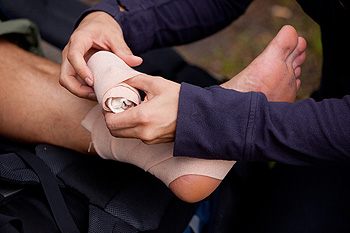Connect With Us
Blog
 Patients who are diabetic can suffer from foot problems. These can include a variety of ailments, including foot ulcers, neuropathy, and bone deformities. Diabetes can happen as a result of elevated blood sugar levels, and it is important to keep blood sugar levels regulated. Minor cuts, scrapes, and bruises can lead to major complications, and the healing process is often delayed. If a foot ulcer has developed, it is important to keep any weight off of the affected foot, as this can help to accelerate healing. If you are diabetic, it is strongly suggested that you regularly have podiatric visits. Podiatrists can help you to manage this condition and its effects on your feet.
Patients who are diabetic can suffer from foot problems. These can include a variety of ailments, including foot ulcers, neuropathy, and bone deformities. Diabetes can happen as a result of elevated blood sugar levels, and it is important to keep blood sugar levels regulated. Minor cuts, scrapes, and bruises can lead to major complications, and the healing process is often delayed. If a foot ulcer has developed, it is important to keep any weight off of the affected foot, as this can help to accelerate healing. If you are diabetic, it is strongly suggested that you regularly have podiatric visits. Podiatrists can help you to manage this condition and its effects on your feet.
Diabetic foot care is important in preventing foot ailments such as ulcers. If you are suffering from diabetes or have any other concerns about your feet, contact Dr. James D. McAlexander from Gig Harbor Foot and Ankle Clinic. Our doctor can provide the care you need to keep you pain-free and on your feet.
Diabetic Foot Care
Diabetes affects millions of people every year. The condition can damage blood vessels in many parts of the body, especially the feet. Because of this, taking care of your feet is essential if you have diabetes, and having a podiatrist help monitor your foot health is highly recommended.
The Importance of Caring for Your Feet
- Routinely inspect your feet for bruises or sores.
- Wear socks that fit your feet comfortably.
- Wear comfortable shoes that provide adequate support.
Patients with diabetes should have their doctor monitor their blood levels, as blood sugar levels play such a huge role in diabetic care. Monitoring these levels on a regular basis is highly advised.
It is always best to inform your healthcare professional of any concerns you may have regarding your feet, especially for diabetic patients. Early treatment and routine foot examinations are keys to maintaining proper health, especially because severe complications can arise if proper treatment is not applied.
If you have any questions please feel free to contact our office located in Gig Harbor, WA . We offer the newest diagnostic and treatment technologies for all your foot and ankle needs.
 A broken toe is a common injury children can incur that parents have to properly address. It can happen as a result of stubbing the toe into a piece of furniture, or from dropping a heavy object on the toe. If the break is severe, the toe may become dislocated. This is noticeable as the bone protrudes from the toe. Many parents will take their child for an X-ray, and this is helpful in determining if a fracture has occurred. An effective treatment method for mildly broken toes can consist of buddy taping. This is accomplished by taping the affected toe to the toe next to it. This is generally effective in providing the support that is needed as the healing process occurs. Common symptoms of a broken toe can include immediate bruising, and it is often difficult to walk. If your child has broken a toe, it is strongly suggested that you seek the advice of a podiatrist who can make a proper diagnosis and offer effective treatment methods.
A broken toe is a common injury children can incur that parents have to properly address. It can happen as a result of stubbing the toe into a piece of furniture, or from dropping a heavy object on the toe. If the break is severe, the toe may become dislocated. This is noticeable as the bone protrudes from the toe. Many parents will take their child for an X-ray, and this is helpful in determining if a fracture has occurred. An effective treatment method for mildly broken toes can consist of buddy taping. This is accomplished by taping the affected toe to the toe next to it. This is generally effective in providing the support that is needed as the healing process occurs. Common symptoms of a broken toe can include immediate bruising, and it is often difficult to walk. If your child has broken a toe, it is strongly suggested that you seek the advice of a podiatrist who can make a proper diagnosis and offer effective treatment methods.
Broken toes may cause a lot of pain and should be treated as soon as possible. If you have any concerns about your feet, contact Dr. James D. McAlexander from Gig Harbor Foot and Ankle Clinic. Our doctor will treat your foot and ankle needs.
What Is a Broken Toe?
A broken toe occurs when one or more of the toe bones of the foot are broken after an injury. Injuries such as stubbing your toe or dropping a heavy object on it may cause a toe fracture.
Symptoms of a Broken Toe
- Swelling
- Pain (with/without wearing shoes)
- Stiffness
- Nail Injury
Although the injured toe should be monitored daily, it is especially important to have a podiatrist look at your toe if you have severe symptoms. Some of these symptoms include worsening or new pain that is not relieved with medication, sores, redness, or open wounds near the toe.
If you have any questions, please feel free to contact our office located in Gig Harbor, WA . We offer the newest diagnostic and treatment technologies for all your foot care needs.
 The medical term for Sever’s Disease is calcaneal apophysitis. It is an uncomfortable foot condition that can affect active teenagers and children as they reach adolescence. It occurs as a result of different growing speeds of the tendons and growth plate in the heel. This can cause the tendons to become tight, putting stress on the heel. Children who frequently participate in running and jumping activities and young teenagers who are overweight may experience Sever’s disease. Mild relief can be found when the affected foot is elevated, and it may help to relieve swelling on the heel by wearing compression socks. If your child or teen is limping, it is suggested that you schedule a consultation with a podiatrist who can help them find the right treatment options.
The medical term for Sever’s Disease is calcaneal apophysitis. It is an uncomfortable foot condition that can affect active teenagers and children as they reach adolescence. It occurs as a result of different growing speeds of the tendons and growth plate in the heel. This can cause the tendons to become tight, putting stress on the heel. Children who frequently participate in running and jumping activities and young teenagers who are overweight may experience Sever’s disease. Mild relief can be found when the affected foot is elevated, and it may help to relieve swelling on the heel by wearing compression socks. If your child or teen is limping, it is suggested that you schedule a consultation with a podiatrist who can help them find the right treatment options.
Sever's disease often occurs in children and teens. If your child is experiencing foot or ankle pain, see Dr. James D. McAlexander from Gig Harbor Foot and Ankle Clinic. Our doctor can treat your child’s foot and ankle needs.
Sever’s Disease
Sever’s disease is also known as calcaneal apophysitis, which is a medical condition that causes heel pain I none or both feet. The disease is known to affect children between the ages of 8 and 14.
Sever’s disease occurs when part of the child’s heel known as the growth plate (calcaneal epiphysis) is attached to the Achilles tendon. This area can suffer injury when the muscles and tendons of the growing foot do not keep pace with bone growth. Therefore, the constant pain which one experiences at the back of the heel will make the child unable to put any weight on the heel. The child is then forced to walk on their toes.
Symptoms
Acute pain – Pain associated with Sever’s disease is usually felt in the heel when the child engages in physical activity such as walking, jumping and or running.
Highly active – Children who are very active are among the most susceptible in experiencing Sever’s disease, because of the stress and tension placed on their feet.
If you have any questions, please feel free to contact our office located in Gig Harbor, WA . We offer the newest diagnostic and treatment technologies for all your foot and ankle injuries.
 The calcaneus is another name for the heel bone, located at the back of the foot. Sometimes, an injury to this area can be severe enough to cause tiny cracks to appear in the bone. This type of stress fracture may occur due to repetitive stress to the heel bone from activities such as running, or due to sudden, high-stress injuries, such as a car accident, a fall from a high position, or a traumatic twisting of the ankle. The symptoms of a calcaneal stress fracture include heel pain, swelling, tenderness, and difficulty walking. If you are experiencing the symptoms of a calcaneal stress fracture, please see a podiatrist.
The calcaneus is another name for the heel bone, located at the back of the foot. Sometimes, an injury to this area can be severe enough to cause tiny cracks to appear in the bone. This type of stress fracture may occur due to repetitive stress to the heel bone from activities such as running, or due to sudden, high-stress injuries, such as a car accident, a fall from a high position, or a traumatic twisting of the ankle. The symptoms of a calcaneal stress fracture include heel pain, swelling, tenderness, and difficulty walking. If you are experiencing the symptoms of a calcaneal stress fracture, please see a podiatrist.
A broken foot requires immediate medical attention and treatment. If you need your feet checked, contact Dr. James D. McAlexander from Gig Harbor Foot and Ankle Clinic. Our doctor can provide the care you need to keep you pain-free and on your feet.
Broken Foot Causes, Symptoms, and Treatment
A broken foot is caused by one of the bones in the foot typically breaking when bended, crushed, or stretched beyond its natural capabilities. Usually the location of the fracture indicates how the break occurred, whether it was through an object, fall, or any other type of injury.
Common Symptoms of Broken Feet:
- Bruising
- Pain
- Redness
- Swelling
- Blue in color
- Numbness
- Cold
- Misshapen
- Cuts
- Deformities
Those that suspect they have a broken foot shoot seek urgent medical attention where a medical professional could diagnose the severity.
Treatment for broken bones varies depending on the cause, severity and location. Some will require the use of splints, casts or crutches while others could even involve surgery to repair the broken bones. Personal care includes the use of ice and keeping the foot stabilized and elevated.
If you have any questions please feel free to contact our office located in Gig Harbor, WA . We offer the newest diagnostic and treatment technologies for all your foot and ankle needs.
Read more about Causes, Symptoms, and Treatment for a Broken Foot A sprained ankle and a broken ankle have similar symptoms and can sometimes be difficult to tell apart. Ankle sprains occur when ligaments in the ankle are overstretched or torn. This can cause symptoms such as pain, swelling, bruising, tenderness, ankle instability, and a restricted range of motion. Sometimes you may also feel a popping sensation at the time of injury. An ankle fracture occurs when one or more bones around the ankle joint break. This can cause an immediate, sharp pain that is usually more painful than a sprain, bruising, swelling, tenderness, a visible deformity, and difficulty bearing weight on the affected ankle. If you have injured your ankle, please see a podiatrist, who can diagnose and treat the injury, as soon as possible.
A sprained ankle and a broken ankle have similar symptoms and can sometimes be difficult to tell apart. Ankle sprains occur when ligaments in the ankle are overstretched or torn. This can cause symptoms such as pain, swelling, bruising, tenderness, ankle instability, and a restricted range of motion. Sometimes you may also feel a popping sensation at the time of injury. An ankle fracture occurs when one or more bones around the ankle joint break. This can cause an immediate, sharp pain that is usually more painful than a sprain, bruising, swelling, tenderness, a visible deformity, and difficulty bearing weight on the affected ankle. If you have injured your ankle, please see a podiatrist, who can diagnose and treat the injury, as soon as possible.
Broken ankles need immediate treatment. If you are seeking treatment, contact Dr. James D. McAlexander from Gig Harbor Foot and Ankle Clinic. Our doctor can provide the care you need to keep you pain-free and on your feet.
Broken Ankles
A broken ankle is experienced when a person fractures their tibia or fibula in the lower leg and ankle area. Both of these bones are attached at the bottom of the leg and combine to form what we know to be our ankle.
When a physician is referring to a break of the ankle, he or she is usually referring to a break in the area where the tibia and fibula are joined to create our ankle joint. Ankles are more prone to fractures because the ankle is an area that suffers a lot of pressure and stress. There are some obvious signs when a person experiences a fractured ankle, and the following symptoms may be present.
Symptoms of a Fractured Ankle
- Excessive pain when the area is touched or when any pressure is placed on the ankle
- Swelling around the area
- Bruising of the area
- Area appears to be deformed
If you suspect an ankle fracture, it is recommended to seek treatment as soon as possible. The sooner you have your podiatrist diagnose the fracture, the quicker you’ll be on the way towards recovery.
If you have any questions, please feel free to contact our office located in Gig Harbor, WA . We offer the newest diagnostic and treatment technologies for all your foot care needs.
 Ankle sprains occur when the ligaments that connect the bones become overstretched or torn. Sprains are one of the most common injuries in sports, and they usually occur when the ankle twists or rolls. Athletes who play sports with a variety of quick changes and directions, such as soccer, football, and basketball, are at a higher risk for developing sprained ankles. Athletes who have previously sprained their ankle are also at a higher risk of re-spraining their ankle as well. Ankle sprains are usually indicated by a “snap” or “crack” at the moment of injury, and bruising and swelling can be present as well. If the sprain is severe, walking and putting weight on the ankle will be difficult. Because an ankle sprain and a fracture can appear similar, patients who believe they have sprained their ankle should consult with a podiatrist to check the extent of their injury. A podiatrist will be able to prescribe medications to reduce the pain as well as provide treatment options in order to allow the ankle to heal.
Ankle sprains occur when the ligaments that connect the bones become overstretched or torn. Sprains are one of the most common injuries in sports, and they usually occur when the ankle twists or rolls. Athletes who play sports with a variety of quick changes and directions, such as soccer, football, and basketball, are at a higher risk for developing sprained ankles. Athletes who have previously sprained their ankle are also at a higher risk of re-spraining their ankle as well. Ankle sprains are usually indicated by a “snap” or “crack” at the moment of injury, and bruising and swelling can be present as well. If the sprain is severe, walking and putting weight on the ankle will be difficult. Because an ankle sprain and a fracture can appear similar, patients who believe they have sprained their ankle should consult with a podiatrist to check the extent of their injury. A podiatrist will be able to prescribe medications to reduce the pain as well as provide treatment options in order to allow the ankle to heal.
Although ankle sprains are common, they aren’t always minor injuries. If you need your ankle injury looked at, contact Dr. James D. McAlexander from Gig Harbor Foot and Ankle Clinic. Our doctor can provide the care you need to keep you pain-free and on your feet.
How Does an Ankle Sprain Occur?
Ankle sprains are the result of a tear in the ligaments within the ankle. These injuries may happen when you make a rapid shifting movement while your foot is planted. A less common way to sprain your ankle is when your ankle rolls inward while your foot turns outward.
What Are the Symptoms?
- Pain at the sight of the tear
- Bruising/Swelling
- Ankle area is tender to touch
- In severe cases, may hear/feel something tear
- Skin discoloration
Preventing a Sprain
- Wearing appropriate shoes for the occasion
- Stretching before exercises and sports
- Knowing your limits
Treatment of a Sprain
In many cases, the RICE method (Rest, Ice, Compression, and Elevate) is used to treat ankle sprains. However, you should see a podiatrist to see which treatment option would work best with your injury. In severe cases, surgery may be required.
It is important to ask your doctor about rehab options after you receive treatment for your injury. Stretching, strength training, and balance exercises may help the ankle heal while also preventing further injury.
If you have any questions, please feel free to contact our office located in Gig Harbor, WA . We offer the newest diagnostic and treatment technologies for all your foot care needs.
Blog Archives
- January 2025
- December 2024
- November 2024
- October 2024
- September 2024
- April 2023
- March 2023
- February 2023
- January 2023
- December 2022
- November 2022
- October 2022
- September 2022
- August 2022
- July 2022
- June 2022
- May 2022
- April 2022
- March 2022
- February 2022
- January 2022
- December 2021
- November 2021
- October 2021
- September 2021
- August 2021
- July 2021
- June 2021
- May 2021
- April 2021
- March 2021
- February 2021
- January 2021
- December 2020
- November 2020
- October 2020
- September 2020
- August 2020
- July 2020
- June 2020
- May 2020
- April 2020
- March 2020
- February 2020
- January 2020
- December 2019
- November 2019
- October 2019
- September 2019
- August 2019
- July 2019
- June 2019
- May 2019
- April 2019
- March 2019
- February 2019
- January 2019
- December 2018
- November 2018
- October 2018
- September 2018
- August 2018
- July 2018
- June 2018
- May 2018
- April 2018
- March 2018
- February 2018
- January 2018
- December 2017
- November 2017
- October 2017


